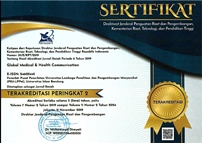Designing Stimulus as Cognitive Task Stimulus for Measurement of Cognitive Bias in Online Gamers
Abstract
Keywords
Full Text:
PDFReferences
Laconi S, Kaliszewska-Czeremska K, Gnisci A, Sergi I, Barke A, Jeromin F, et al. Cross-cultural study of problematic internet use in nine European countries. Comput Human Behav. 2018;84:430–40.
Lopez-Fernandez O, Romo L, Kern L, Rousseau A, Lelonek-Kuleta B, Chwaszcz J, et al. Problematic Internet Use among adults: a cross-cultural study in 15 countries. J Clin Med. 2023;12(3):1027.
King D, Delfabbro P, Griffiths M. Video game structural characteristics: a new psychological taxonomy. Int J Ment Health Addict. 2010;8(1):90–106.
Brand M, Young KS, Laier C, Wölfling K, Potenza MN. Integrating psychological and neurobiological considerations regarding the development and maintenance of specific Internet-use disorders: an Interaction of Person-Affect-Cognition-Execution (I-PACE) model. Neurosci Biobehav Rev. 2016;71:252–66.
Decker SA, Gay JN. Cognitive-bias toward gaming-related words and disinhibition in World of Warcraft gamers. Comput Human Behav. 2011;27(2):798–810.
Zhou Z, Yuan G, Yao J. Cognitive biases toward internet game-related pictures and executive deficits in individuals with an internet game addiction. PLoS One. 2012;7(11):e48961.
Yang W, Makita K, Nakao T, Kanayama N, Machizawa MG, Sasaoka T, et al. Affective auditory stimulus database: an expanded version of the International Affective Digitized Sounds (IADS-E). Behav Res Methods. 2018;50(4):1415–29.
Chia DXY, Zhang MWB. A scoping review of cognitive bias in internet addiction and internet gaming disorders. Int J Environ Res Public Health. 2020;17(1):373.
Fazio RH, Olson MA. Implicit measures in social cognition research: their meaning and use. Annu Rev Psychol. 2003;54:297–327.
Brooks S, Prince A, Stahl D, Campbell IC, Treasure J. A systematic review and meta-analysis of cognitive bias to food stimuli in people with disordered eating behaviour. Clin Psychol Rev. 2011;31(1):37–51.
Stormark KM, Torkildsen Ø. Selective processing of linguistic and pictorial food stimuli in females with anorexia and bulimia nervosa. Eat Behav. 2004;5(1):27–33.
Nosek BA, Banaji MR. The Go/No-Go association task. Soc Cogn. 2001;19(6):625–64.
Duffy RD, Autin KL, Bott EM. Work volition and job satisfaction: Examining the role of work meaning and person-environment fit. CDQ. 2015;63(2):126–40.
Hwang YH, Kim HK, Sohn YH; Namil Study Group, Korean Glaucoma Society. Central corneal thickness in a Korean population: the Namil study. Invest Ophthalmol Vis Sci. 2012;53(11):6851–5.
Huanhuan L, Su W. The role of cognitive distortion in online game addiction among Chinese adolescents. Child Youth Serv Rev. 2013;35(9):1468–75.
King D, Delfabbro P. Internet gaming disorder: theory, assessment, treatment, and prevention. Cambridge: Academic Press; 2019.
Király O, Griffiths MD, Urbán R, Farkas J, Kökönyei G, Elekes Z, et al. Problematic internet use and problematic online gaming are not the same: findings from a large nationally representative adolescent sample. Cyberpsychol Behav Soc Netw. 2014;17(12):749–54.
Diantina FP, Permana RH, Khasanah AN, Pratama RA, Halwa A, Rahma D, et al. Development of a qualitative assessment instrument for cognitive processes in gaming decision. GMHC. 2023;11(3):209–17.
Braun V, Clarke V. Using thematic analysis in psychology. Qual Res Psychol. 2006;3(2):77–101.
Baggio S, Dupuis M, Studer J, Spilka S, Daeppen JB, Simon O, et al. Reframing video gaming and internet use addiction: empirical cross-national comparison of heavy use over time and addiction scales among young users. Addiction. 2016;111(3):513–22.
Antony S, Tramboo IA. Hyperreality in media and literature: an overview of Jean Baudrillard’s simulacra and simulation. Eur J Mol Clin Med. 2020;7(10):3314–8.
Kowert R, Domahidi E, Festl R, Quandt T. Social gaming, lonely life? The impact of digital game play on adolescents’ social circles. Comput Human Behav. 2014;36:385–90.
Xu K, Geng S, Dou D, Liu X. Relations between video game engagement and social development in children: the mediating role of executive function and age-related moderation. Behav Sci (Basel). 2023;13(10):833.
King DL, Delfabbro PH. The cognitive psychology of Internet gaming disorder. Clin Psychol Rev. 2014;34(4):298–308.
Morris LS, Voon V. Dimensionality of cognitions in behavioral addiction. Curr Behav Neurosci Rep. 2016;3:49–57.
Snodgrass JG, Dengah II HJF, Lacy MG, Bagwell A, Van Oostenburg M, Lende D. Online gaming involvement and its positive and negative consequences: a cognitive anthropological “cultural consensus” approach to psychiatric measurement and assessment. Com Hum Behav. 2017;66:291–302.
Zeng W, Wei H, Liu M. Need for distinctiveness leads to pathological internet use? The perspective of cognitive behavioral model. Int J Environ Res Public Health. 2023;20(2):1609.
Goldstein RZ, Woicik PA, Lukasik T, Maloney T, Volkow ND. Drug fluency: a potential marker for cocaine use disorders. Drug Alcohol Depend. 2007;89(1):97–101.
Berridge KC, Robinson TE. Liking, wanting, and the incentive-sensitization theory of addiction. Am Psychol. 2016;71(8):670–9.
Jonkman LM. The development of preparation, conflict monitoring and inhibition from early childhood to young adulthood: a Go/Nogo ERP study. Brain Res. 2006;1097(1):181–93.
Kirmizi-Alsan E, Bayraktaroglu Z, Gurvit H, Keskin YH, Emre M, Demiralp T. Comparative analysis of event-related potentials during Go/NoGo and CPT: decomposition of electrophysiological markers of response inhibition and sustained attention. Brain Res. 2006;1104(1):114–28.
DOI: https://doi.org/10.29313/gmhc.v13i1.14135
pISSN 2301-9123 | eISSN 2460-5441
Visitor since 19 October 2016:
Global Medical and Health Communication is licensed under a Creative Commons Attribution-NonCommercial-ShareAlike 4.0 International License.































.png)
_(1).png)
_(1).jpg)
